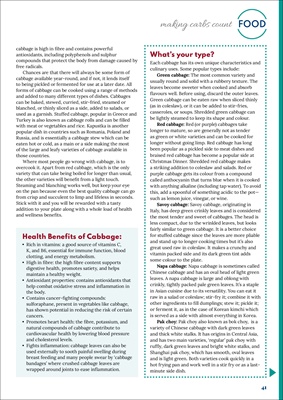
41
FOOD
making carbs count
cabbage is high in fibre and contains powerful
antioxidants, including polyphenols and sulphur
compounds that protect the body from damage caused by
free radicals.
Chances are that there will always be some form of
cabbage available year-round, and if not, it lends itself
to being pickled or fermented for use at a later date. All
forms of cabbage can be cooked using a range of methods
and added to many different types of dishes. Cabbages
can be baked, stewed, curried, stir-fried, steamed or
blanched, or thinly sliced as a side, added to salads, or
used as a garnish. Stuffed cabbage, popular in Greece and
Turkey is also known as cabbage rolls and can be filled
with meat or vegetables and rice. Kapustka is another
popular dish in countries such as Romania, Poland and
Russia, and is essentially a cabbage stew which can be
eaten hot or cold, as a main or a side making the most
of the large and leafy varieties of cabbage available in
those countries.
Where most people go wrong with cabbage, is to
overcook it. Apart from red cabbage, which is the only
variety that can take being boiled for longer than usual,
the other varieties will benefit from a light touch.
Steaming and blanching works well, but keep your eye
on the pan because even the best quality cabbage can go
from crisp and succulent to limp and lifeless in seconds.
Stick with it and you will be rewarded with a tasty
addition to your plate along with a whole load of health
and wellness benefits.
What's your type?
Each cabbage has its own unique characteristics and
culinary uses. Some popular types include:
Green cabbage: The most common variety and
usually round and solid with a rubbery texture. The
leaves become sweeter when cooked and absorb
flavours well. Before using, discard the outer leaves.
Green cabbage can be eaten raw when sliced thinly
(as in coleslaw), or it can be added to stir-fries,
casseroles, or soups. Shredded green cabbage can
be lightly steamed to keep its shape and colour.
Red cabbage: Red (or purple) cabbages take
longer to mature, so are generally not as tender
as green or white varieties and can be cooked for
longer without going limp. Red cabbage has long
been popular as a pickled side to meat dishes and
braised red cabbage has become a popular side at
Christmas Dinner. Shredded red cabbage makes
a striking addition to coleslaw and salads. Red or
purple cabbage gets its colour from a compound
called anthocyanin that turns blue when it is cooked
with anything alkaline (including tap water). To avoid
this, add a spoonful of something acidic to the pot-
such as lemon juice, vinegar, or wine.
Savoy cabbage: Savoy cabbage, originating in
Italy, has deep green crinkly leaves and is considered
the most tender and sweet of cabbages. The head is
less compact, due to the wrinkled leaves, but looks
fairly similar to green cabbage. It is a better choice
for stuffed cabbage since the leaves are more pliable
and stand up to longer cooking times but it's also
great used raw in coleslaw. It makes a crunchy and
vitamin packed side and its dark green tint adds
some colour to the plate.
Napa cabbage: Napa cabbage is sometimes called
Chinese cabbage and has an oval head of light green
leaves. A napa cabbage is large and oblong with
crinkly, tightly packed pale green leaves. It's a staple
in Asian cuisine due to its versatility. You can eat it
raw in a salad or coleslaw; stir-fry it; combine it with
other ingredients to fill dumplings; stew it; pickle it;
or ferment it, as in the case of Korean kimchi which
is served as a side with almost everything in Korea.
Pak choy: Pak choy also known as bok choy, is a
variety of Chinese cabbage with dark green leaves
and thick white stalks. It has origins in Central Asia,
and has two main varieties, 'regular' pak choy with
ruffly, dark green leaves and bright white stalks, and
Shanghai pak choy, which has smooth, oval leaves
and is light green. Both varieties cook quickly in a
hot frying pan and work well in a stir fry or as a lastminute side dish.
Health Benefits of Cabbage:
• Rich in vitamins: a good source of vitamins C,
K, and B6, essential for immune function, blood
clotting, and energy metabolism.
• High in fibre: the high fibre content supports
digestive health, promotes satiety, and helps
maintain a healthy weight.
• Antioxidant properties: contains antioxidants that
help combat oxidative stress and inflammation in
the body.
• Contains cancer-fighting compounds:
sulforaphane, present in vegetables like cabbage,
has shown potential in reducing the risk of certain
cancers.
• Promotes heart health: the fibre, potassium, and
natural compounds of cabbage contribute to
cardiovascular health by lowering blood pressure
and cholesterol levels.
• Fights inflammation: cabbage leaves can also be
used externally to sooth painful swelling during
breast feeding and many people swear by 'cabbage
bandages' where crushed cabbage leaves are
wrapped around joints to ease inflammation.